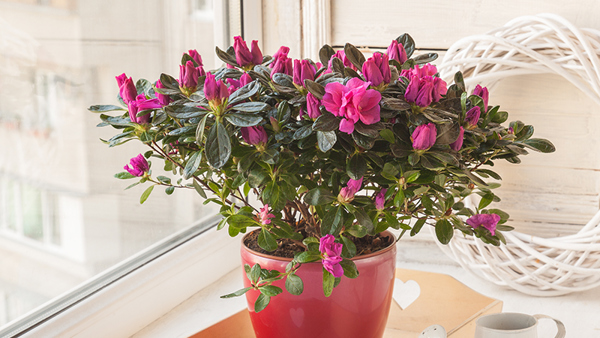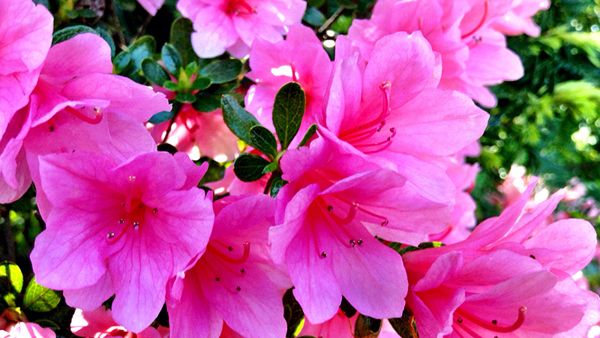Yates Account
Join now
Create a Yates account today!
Sign up to join the Yates Garden Club for monthly e-mails packed with seasonal inspiration, tips for success & exclusive promotions.
Plus if you’re a Garden Club member you can take part in the Yates Growing Community - a blog to share successes, get advice & win prizes in fun challenges along the way!

Forgot password
Enter the email address associated with your account, and we'll email you a new password.

If you are looking for a real punch of colour in winter and spring then you can’t go past Azaleas. They vary in size from small, rather delicate perennial shrubs, to the large, hardy indica varieties that seem able to survive all the climatic challenges that are thrown at them. Flowers can be in either single or double form and are available in such a wide range of colours.
How to grow azaleas in a garden
- Choose a spot in the garden with semi-shade and that gets protection from the harsh afternoon sun. Enrich the soil with Yates Dynamic Lifter Organic Plant Food. If the soil is clay-based, add gypsum and fork in well.
- Dig the planting hole twice as wide and to the same depth as the root-ball. Remove the shrub from the container, gently tease the roots.
- Position in hole and backfill, gently firming down. Form a raised ring around the plant, creating a well so that water will go where it’s needed most. Water in well.
- Mulch around the base with organic mulch like bark chips or pea straw, keeping it away from the main stem.
- Feed regularly with Yates Thrive Camellia, Gardenia & Blueberry Granular Plant Food.


How to grow azaleas in a pot
- Choose a pot at least 600mm wide. Position in semi-shade and fill with quality potting mix, such as Yates Premium Potting Mix.
- Remove the shrub from the container, gently tease the roots.
- Position in hole and backfill, gently firming down. Water in well.
- Feed every 1-2 weeks with Yates Thrive Roses & Flowers Liquid Plant Food. TIP: For an added boost apply Yates Thrive Natural Fish & Seaweed+ Plant Food Concentrate.
Growing tips
- Prune immediately after flowering finishes. With some varieties blooming continues for months so it’s important to be patient.
- Always maintain a layer of organic mulch (e.g. a 10 centimetre thickness of old leaves) over the shallow roots. This insulates the roots and helps protect them from drying out.
- In order to achieve success with azaleas in alkaline soil areas, mix some moistened peat moss and milled cow manure into the planting area.
- To achieve a slightly acidic soil you may need to apply Yates Soil Acidifer Liquid Sulfur to lower the pH of the soil.
- Get your plants ready for the summer months by giving them a feed and a trim after flowering.
- Azaleas are not recommended for planting in kids' gardens as the plant is poisonous if consumed.
Here are a few simple steps to keeping your azaleas looking fantastic:
- Azaleas prefer an acidic soil (with a pH of 5.5–6.0) so in areas with alkaline (basic) soil, apply Yates Soil Acidifier Liquid Sulfur to reduce the soil pH.
- To help promote healthy foliage growth and lots of beautiful flowers, feed azaleas with Yates Thrive Camellia, Gardenia & Blueberry Granular Plant Food. It contains more than 50% natural ingredients, boosted with fast-acting fertilisers. It contains extra potassium to promote lots of flowers as well as nitrogen and phosphorus to encourage healthy leaf and stem growth and a strong root system. Scatter around the root zone of azaleas every 8 weeks and water in well after applying
Hellebores are the moody, gothic jewels of the winter garden. Learn how you can grow them in garden or in pots.
Gardenia
Gardenias have soft scented blooms in white or yellow. Depending on the variety, can be grown as a shrub, standard, hedge or ground cover.
Freesia
Freesias are a spring flowering bulb that produce scented blooms in a range of vibrant colours including pinks, white, yellow, mauve and red.
Flax
Flax (Phormium spp.) are highly versatile plants which can grow well in swampy or dry conditions. Great for large pots or en-masse in garden beds.
Recommended products
Yates Dynamic Lifter Organic Plant Food
Releases nutrients slowly, improves the structure and moisture retention of the soil and encourages earthworms and beneficial soil micro-organisms.
Yates Thrive Camellia, Gardenia & Blueberry Plant Food
Specially formulated to feed acid-loving plants such as camellias, gardenias, daphnes, azaleas, rhododendrons and blueberries for up to 3 months.
Yates Premium Potting Mix
A premium potting mix, ideal for all potted plants and shrubs, including ornamentals, fruit trees, vegies and herbs.
Yates Thrive Natural Fish & Seaweed+ Plant Food Concentrate
A complete plant food enriched with natural fish, seaweed, humates, molasses and more - boosted with NPK to improve plant and soil vitality.
















Share
Share this article on social media